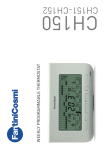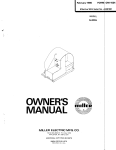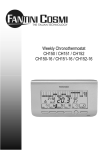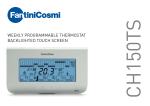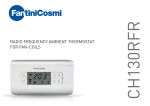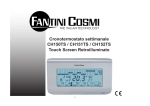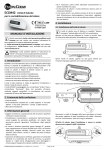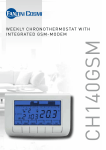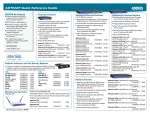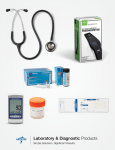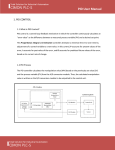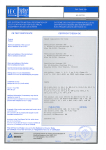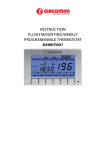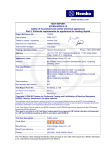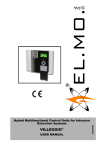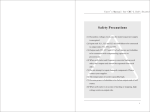Download Radio wave weekly program chronothermostat CH150RF
Transcript
Radio wave weekly program chronothermostat CH150RF / CH151RF / CH152RF 1 INDEX separate probe ������������������������������������������������15 Introduction ��������������������������������������������������������������3 Statistical data �������������������������������������������������15 Controls and indications ������������������������������������������4 Setting the desired humidity level ��������������������16 Controls �������������������������������������������������������������4 Maintenance ����������������������������������������������������������17 Indications ���������������������������������������������������������5 Replacing the batteries ������������������������������������17 User manual ������������������������������������������������������������6 Installation �������������������������������������������������������������18 Setting the date and time ����������������������������������6 Installing the batteries �������������������������������������18 Summer/Winter selection ����������������������������������7 Configuring the chronothermostat �������������������18 Operating modes �����������������������������������������������7 Actuator registration ����������������������������������������23 “Manual” operating mode ����������������������������������7 Fastening the socket ���������������������������������������25 “Automatic” operating mode ������������������������������8 Electric connections ����������������������������������������26 “Holiday” operating mode ��������������������������������10 Securing the chronothermostat to the socket ��27 “Jolly” operating mode �������������������������������������10 Technical features �������������������������������������������������27 “OFF” function �������������������������������������������������12 Preset programs ����������������������������������������������13 Chronothermostat programming ���������������������13 Displaying the temperature detected by the 2 Introduction control through the DTMF keypad (multi-tone) • Telephone actuator with GSM modem, used for remote control by means of SMS messages. The CH150RF/151RF/152RF chronothermostat measures the ambient temperature and controls the heating (conditioning) system through a radio connection with an actuator. A humidistat can also be driven. The operating mode can be either chosen from among the preset ones or customized to one’s own needs. The large display shows the temperature profile – i.e. the relationship between the time table and the temperature to be kept – as well as the measured temperature, relative humidity, calculated perceived temperature, time and day of the week. The chronothermostat is battery powered. Both the settings and the data are stored in a non-volatile memory capable of keeping them even when the batteries are down. The following external interfaces are available for the CH150RF chronothermostat: • Radio actuator • Separate temperature probe • Telephone actuator for fixed telephone lines, which makes it possible to perform remote Both telephone actuators allow you to: • remotely interrogate the chronothermostat, to be informed about the ambient temperature or the heating / cooling system status; • remotely manage the chronothermostat operating modes. The chronothermostat comes in three colours: white, silver (CH151RF series) and anthracite black (CH152RF series). 3 Controls and indications 7. Rotary selector for temperature correction: T1, Manual temperature, Jolly temperature, and Antifreeze temperature * 8. Rotary selector for correcting temperature T2 or the Jolly operating mode duration * 9. Rotary selector for correcting temperature T3 or the Jolly operating mode duration 10. Summer/Winter switching button 11. Chronothermostat reset button Controls 11 10 9 8 7 1 2 3 4 5 * The function associated with the button or selector depends on the current operating mode. It is highlighted by the icon placed above. 6 1. Button used to select the “Manual” operating mode or increase a value (▲) * 2. Button used to select the “Automatic” operating mode or decrease a value (▼) * 3. Button used to select the “Holiday” operating mode or go back to the previous data item (◄) * 4. Button used to select the “Jolly” operating mode or go to the next data item (►) * 5. Button used for the “OFF” or “Enter” functions * 6. Button used for the “Programming” or “Copy” or “Statistical data displaying” functions * 4 Indications 14 1 2 3 4 1. Time 2. Temperature profile 3. Temperature value T1 or “Jolly” operating mode duration (days) 4. Temperature value T2 or “Jolly” operating mode duration (hours) 5. Temperature value T3 6. System ON in Summer operation 7. System ON in Winter operation 8. Relative humidity percentage 9. Perceived temperature (displayed by the degree) 10. Ambient/external temperature 11. Current day (1 = Monday … 7 = Sunday; 8 = Holiday) 12. Winter operation 13. Summer operation 14. Battery charge level 15. Humidistat enable 16. Humidistat ON 5 16 13 12 11 10 8 9 15 7 6 5 User manual 2. Modify the hour setting by means of the ▲ and ▼ buttons, then go to the minute setting by means of the ► button. To operate the chronothermostat after it has been installed, proceed as follows: 1. Set the date and time. 2. Select the Summer/Winter operation. 3. Select the operating mode. Setting the date and time To set the current time and date, proceed as follows: 1. Enter the programming menu main page. The operating mode currently used will be interrupted temporarily. Choose the time setting function. 3. Modify the minute setting by means of the ▲ and ▼ buttons, then go to the day setting by means of the ► button. 4. Modify the day setting by means of the ▲ button, then press ENTER to go back to the main page of the programming menu. 6 Operating modes The CH150/151/152 chronothermostat features four different operating modes: Manual, Automatic, Holiday and Jolly (in addition to the OFF function). 5. Press ENTER again to exit the programming menu. The chronothermostat operating mode previously interrupted will be resumed. “Manual” operating mode With the Manual operating mode, the chronothermostat adjusts the operation of the heating or cooling system in order to always keep the same temperature. To select “Manual”, press MAN. Summer/Winter selection To shift from the Summer operation (heating system) to the Summer operation (cooling system), and vice versa, keep the Summer/Winter button depressed for at least 4 seconds. The selected operation will be shown on the display by means of the “Winter” or “Summer” icons. Winter Summer 7 “Automatic” operating mode With the “Automatic” operating mode, the chronothermostat adjusts the operation of the heating or cooling system by following the profiles defined for the various days of the week. To select “Automatic”, press AUTO. The temperature level can be modified during operation by means of the lower rotary selector located on the right side of the chronothermostat. The temperature can be changed from 2°C to 40 °C by 0.1°C increments. The three temperature levels used can be modified during operation by means of the rotary selectors located on the right side of the chronothermostat. 8 Temperature T3 cannot be lower than temperature T2 or higher than 40 °C. During Summer operation, temperature T3 features an upper limit of 30°C. When this value is exceeded, T3 will take the OFF value, which will involve switching the system off. Temperature T1 cannot be higher than temperature T2 or lower than 2 °C. If no customization has been made, the automatic operating mode will function with the stored temperature profiles, i.e. the preset ones (refer to «Preset programs»). To customize the profiles, refer to «Chronothermostat programming». Temperature T2 cannot be higher than temperature T3 or lower than temperature T1. 9 “Holiday” operating mode With the “Holiday” operating mode, the CH150 chronothermostat CH150 adjusts the operation of the heating or cooling system by following one single temperature profile, which is valid for all days. To select “Holiday”, press HOLIDAY. “Jolly” operating mode “Jolly” operating mode With the “Jolly” operating mode, the CH150 chronothermostat interrupts the current operating mode and adjusts the operation of the heating or cooling system to keep the “Jolly” temperature during the entire time set (1 hour to 99 days and 23 hours, by 1 hour increments). After this time – which is displayed like a countdown – has elapsed, the previous operation of the chronothermostat will be resumed. To select “Jolly”, press JOLLY. To modify the temperature levels, refer to the description of the “Automatic” operating mode. When the preset programs are used (refer to «Preset programs»), the “Holiday” mode will follow the profile envisaged for Saturdays and Sundays. To create a customized “Holiday” program, refer to «Chronothermostat programming». The “Jolly” temperature value and the operating mode duration can be modified by means of the rotary selectors located on the right side of the chronothermostat. 10 Use the lower rotary selector to modify the temperature level. The temperature can be modified from 2°C to 40 °C, by 0.1 °C increments. To set the “Jolly” operating mode duration, i.e. days («d»), use the upper rotary selector. The days can range from 0 to 99. You can interrupt the “Jolly” mode at any time, by selecting any other operating mode. To set the “Jolly” operating mode duration, i.e. hours («h»), use the central rotary selector. The hours can range from 0 to 23. The “Jolly” operating mode can be used, for instance, to: • save energy by lowering the temperature when the house is not inhabited at the weekends or winter vacation, while being sure that a comfortable temperature will exist when the house is inhabited again); • extend the night heating or cooling beyond the usual time, i.e. when you stay up in the company of your guests. 11 “OFF” function The “OFF” function can be activated by pressing OFF. Winter operation Summer operation The chronothermostat adjusts the operation of the heating system to keep the “Antifreeze” temperature, in order to reduce the energy consumption and, at the same time, avoid any damage caused by extremely low temperatures. The system will be fully turned off and the “OFF” message will appear on the display, without any temperature profile. The “Antifreeze” temperature can be modified from 2°C to 7°C (by 0.1°C increments), by using the lower rotary selector. If a temperature of less than 2°C is set, the system will be fully turned off and the antifreeze protection will be lost. 12 Preset programs The CH150 chronothermostat features two preset programs (i.e. “Winter” and “Summer”) for quicker start-up. Chronothermostat programming You can customize the temperature profiles for the “Automatic” and “Holiday” operating modes, so as to adapt them to your own needs. To set new temperature profiles, proceed as follows: “Winter” program – working days (Mondays through Fridays) 1. Enter the programming menu main page. The operating mode currently used will be interrupted temporarily. Choose the temperature profile customization function. “Winter” program – public holidays (Saturdays, Sundays and “Holiday” program) “Summer” program (All days of the week, plus “Holiday” program) 13 2. The Monday profile (DAY 1) for “Winter” operation (icon ) will be displayed. Use the ◄ and ► buttons to move the bar chart blinking segment to the time at which the temperature is to be modified. Each segment equals half an hour. To modify the “Summer” operation profile (icon ), press the “Summer/Winter” button on the left side of the chronothermostat. 4. To directly duplicate the temperature profile by going to the next day, press COPY (to customize every single day separately, refer to step 5 below). 5.Press ENTER to go to the next day, then repeat the operations described starting from step 2 for the other days of the week (the “Holiday” profile will be indicated as DAY 8). To go back to the programming menu main page, use the ENTER button to scroll through the eight days or keep the ENTER button depressed for 3 seconds. 3. Use the ▲ and ▼ buttons to modify the temperature level (T1, T2 or T3). If no button is pressed within the next three minutes, the chronothermostat operating mode previously used will be resumed. 14 Preset parameter reset To resume the preset temperature profiles and values (T1-T2-T3-Temperature used with the Manual mode, Temperature used with the Jolly mode, Antifreeze temperature, OFF function), keep the ▲ and ▼ buttons depressed simultaneously when you are in the temperature profile programming mode. Statistical data The CH150 chronothermostat provides a set of statistical data concerning the system operation. To access this data, proceed as follows: 1. Enter the programming menu main page. The operating mode currently used will be interrupted temporarily. Choose the statistical data function. Displaying the temperature detected by the separate probe To display the temperature detected by the separate probe (only if the latter has been configured as an external probe or floor-mounted probe), the chronothermostat must be configured (refer to <<chronothermostat configuration>>) and the probe must be connected. To display the temperature value read by the separate probe, press the button of the operating mode currently used (the temperature will blink). To display again the temperature detected by the chronothermostat, press again the button of the operating mode currently used (the temperature will not blink any longer). 2. Page 1: number of hours during which the system was operated on the previous day (6 hours in the image). Use the ► button to go to the next page. 15 Setting the desired humidity level The CH150RF/151RF/152RF chronothermostat allows you to actuate a humidistat by setting the desired humidity value. To be able to actuate a humidistat, it is requested that this function will be enabled through the technical menu (refer to the <<Chronothermostat configuration>> chapter). To set the desired humidity value, proceed as follows: 3. Page 2: total number of hours during which the system has been switched on and operating since its first start-up (16 hours in the image). Use the ► button to go to the next page. Press the ▲ and ▼ buttons simultaneously to reset the total system switch-on hours. 4.Page 3: minimum temperature reached on the current day, and time at which such minimum temperature was reached (15.8°C at 03.15 a.m. in the image). Use the ► button to go to the next page. 1. Enter the programming menu main page. The operating mode currently used will be interrupted temporarily. Choose the time table setting function. 5. Page 4: maximum temperature reached on the current day, and time at which such maximum temperature was reached (22.5°C at 09.08 p.m. in the image). 6. Press the ENTER button twice to go back to the operating mode previously used. 16 Maintenance 2. Use the ► button to move and highlight the set humidity value. The chronothermostat can be cleaned by using a soft cotton cloth (no detergent must be used). Replacing the batteries When the battery charge level starts to read low, the symbol will start blinking on the display. If the batteries are not replaced within 15 days, the chronothermostat will be automatically turned off and the “OFF” message will appear on the display instead of the temperature. The settings and data are kept in the non-volatile memory. 3. Modify this value by pressing the ▲ and ▼ buttons until the desired value is displayed. Press ENTER to go back to the programming menu main page. 4. Press ENTER again to exit the programming menu. The chronothermostat operating mode previously interrupted will be resumed. 17 To remote the chronothermostat from its socket, proceed as follows: • remove the telephone actuator jack connector (if any); • pull the chronothermostat on its left and right sides, without applying force to the selectors. If only the “OFF” message appears on the display when the batteries haven been replaced, press the round button [button 5] after the chronothermostat has been fitted back to the socket. Installing the batteries Separate the socket from the chronothermostat by levering on the slot found at the socket bottom by using a suitable tool. Insert two long-life AA alkaline batteries (1.5 V) into the chronothermostat rear (observe the correct polarity). After installing the batteries, the chronothermostat will turn on automatically. Fasten the socket back again, making sure that the multi-pole connector is inserted correctly. The chronothermostat will click into position. Important! The standard battery service life is more than 1 year. It is recommended that the batteries should be replaced at the start of the system operation season, to prevent the batteries from running out when you are away from home, e.g. during the summer or Christmas holidays. The batteries must be properly disposed of in special containers. Installation Warning! The unit must be installed only by qualified personnel, in compliance with the law regulations in force. Configuring the chronothermostat Warning! The chronothermostat must be configured only by qualified personnel. The chronothermostat installation involves the following operations: • Installing the batteries • Configuring the chronothermostat parameters • Registering the chronothermostat with the radio actuators • Fastening the socket to the wall • Making the electric connections • Securing the chronothermostat onto the socket. 18 By configuring the chronothermostat, the device operation parameters can be customized. To access the configuration program, proceed as follows: 1. Press the SET / PROG button [button 6]. The operating mode currently used will be temporarily interrupted and will be automatically resumed at the end of programming. 2. Keep the SUMMER / WINTER switching button [button 10] depressed for approximately 5 seconds. Each configuration parameter, which features its own preset settings, is identified on the display by an index and a writing. To modify the parameter values, use the ▲ [button 1] and ▼ [button 2] buttons. To move across the parameters, use the ► [button 4] button. To go back to the initial page of the programming menu, press the ENTER [button 5] button, which will store the modifications into the memory. If no button is pressed within 3 minutes, the chronothermostat will exit the configuration program and the operating mode previously used will be resumed, without saving. To eliminate the modifications made and resume the preset configuration parameter values, keep the ▲ [button 1] and ▼ [button 2] buttons depressed simultaneously for approximately 4 seconds. 19 In- Parameter dex Writing Values Preset value 1 Type of connected card COn rEL/ rAd / --- None 2 Heating actuator registration radio control rF t -- - --- 3 Humidity adjustment enable rH ON/OFF OFF 3A Humidification rF rH actuator registration radio control -- - --- 4 Temperature scale CELS °C / °F or FHAr °C 5 Type of adjustment Std or ProP Std / ProP Std 5A Thermal differential DIFF HI / LO LO 5A Adjustment band bAnd 1 °C – 4 °C 2 °C (step 0.1°C) 5B Adjustment period PEr 5 / 10 / 20 10 minutes minutes 6 Separate temperature probe configuration SEct --- / FLO / In --/ Out 6A Floor temperature limit tFLO 15 °C – 45 °C 27.0 °C In- Parameter dex Writing Values 7 Ambient temperature correction Corr -4.0 °C +4.0 °C 8 Optimization OPt ON/OFF OFF 8A Optimization max. duration (hours) OPtH 1h – 5h 2h 9 Pump antiscuff Pu ON/OFF OFF 10 Software version and radio address SOFt xxx xxx Type of connected card The chronothermostat is capable of verifying whether the socked is connected. If the socket is not connected, the dashes will be displayed; it if is, the “rAd” writing will appear. Preset value to 0.0 °C Heating system actuator registration radio control It makes it possible, by pressing the button, to send the actuator registration radio control used for the heating system. Refer to the <<Radio actuator configuration>> chapter for more information. Humidity adjustment enable It makes it possible to operate a humidistat in order to humidify an environment until the desired humidity level is reached. Refer to the <<Setting the desired humidity level>> chapter for more information. 20 Humidification system actuator registration radio control It makes it possible, by pressing the button, to send the actuator registration radio control used for the humidification system. Refer to the <<Radio actuator configuration>> chapter Adjustment band It sets the adjustment band when the proportional temperature adjustment mode is chosen. Select an appropriate value on the basis of the system’s temperature gradient (wide band for very high gradients; narrow band for low gradients). for more information. This menu item will be displayed only if the humidity adjustment has been enabled. Temperature scale It selects the scale, i.e. Celsius (centigrade) or Fahrenheit degrees, by means of which all the temperatures will be displayed. In the event that the Fahrenheit scale is used, the temperatures may range from 0.0 to 99.9°F. Adjustment period It sets the adjustment cycle duration (switchon + switch-off period) when the proportional temperature adjustment mode is chosen. Select 5 minutes for low-inertia systems (fan-coil type), 10 minutes for average-inertia systems (aluminium radiator type) and 20 minutes for high-inertia systems (cast-iron radiator type). Type of adjustment It selects the temperature adjustment mode: differential (Std) or proportional (ProP). This parameter is used only for heating. Thermal differential It sets the thermal differential value to be used when the differential temperature adjustment mode is selected. By properly choosing the differential, on the basis of the thermal inertia of the heating system, continuous switch-on and switch-off will be avoided. It is recommended that the low thermal differential (LO) should be used for the heating systems equipped with radiators, and the high thermal differential (HI) should be used for the systems equipped with fan-coils. Separate temperature probe configuration A separate temperature probe can be connected to the chronothermostat: the operation of such probe is determined by this parameter. • Probe OFF (---): the temperature value detected by the probe, even if the latter is connected, will not be used. 21 • Floor probe (FLO): when the temperature detected by the probe reaches the value set in the Floor temperature limit parameter, the system will be switched off regardless of the temperature detected by the chronothermostat. Ambient temperature correction It makes it possible to sum/subtract an offset value to/from the temperature value measured by the chronothermostat. • Ambient probe (In): the system adjustment is based on the temperature value detected by the separate probe. This temperature will be shown on the display in place of the one detected by the probe inside the chronothermostat. The separate ambient probe will be used only when the chronothermostat is necessarily situated in a different ambient from the one the temperature of which is to be checked. Optimization It calculates the spark lead required to reach the desired temperature at the established time, considering the system’s thermal inertia. The optimization takes place only on the first switch-on instance of the day, i.e. on the first programmed passage from a temperature to a higher one. Optimization maximum duration It sets the maximum duration (hours) of the preliminary ignition calculated by the optimization. • External probe (Out): it will not affect the system adjustment and will be used to merely know an extra temperature value, e.g. the external temperature. Pump antiscuff It turns the system on for 1 minute every day (h 23.58) by making the water circulating pump to run, in order to prevent pump seizing. This takes place only if the system has never been turned on during the day. Floor temperature limit It sets the temperature limit value read by the separate probe which turns the system off when the floor probe is used (for the floor heating systems). 22 Software revision and radio address It displays the software revision for the unit in which the ambient temperature is usually indicated, and also the radio address in which the three temperature T3, T2 and T1 are usually displayed. By pressing the ▲ and ▼ buttons simultaneously for more than 4 seconds, you can change the chronothermostat radio address. Following this procedure, the radio actuators previously registered shall be configured again (refer to the <<Actuator registration>> chapter). Actuator registration Prior to starting up the system, the radio actuators shall be registered to the CH150RF, CH151RF, CH152RF chronothermostat. To avoid memorizing a code belonging to another chronothermostat, the reception sensitivity during the configuration procedure is reduced; therefore, the chronothermostat and the actuator should be positioned at a distance of less than 2 m. Moreover, you should verify that the radio socket is correctly connected with the chronothermostat (refer to Index 1 of the configuration menu, <<Chronothermostat configuration>> chapter). 23 Heating system actuator registration: 1. Set the actuator to the “system code selflearning” mode (refer to the actuator instruction sheet). 2. Send the heating system actuator registration radio control (refer to index 2 of the configuration menu, <<Chronothermostat configuration>> chapter): 2A. Press SET / PROG [button 6]. The operating mode currently used will be temporarily interrupted. 2B. Keep the SUMMER / WINTER switching button [button 10] depressed for approximately 5 seconds, to display the initial page of the programming menu. 2C. Press ► [button 4] to select the second parameter (the “rF t” message will appear on the display; the displayed index will be number 2). 2D. Press [button 1] to send the heating system actuator registration radio control. The “rF t” message will blink: verify that the actuator is registered after a few seconds. 2E. Press ENTER [button 5] to go back to the initial page of the programming menu; press the same button again to go back to the operating mode currently used. 3. Repeat the operations described in steps 1 and 2 in the event that several actuators are used. Humidification system actuator registration: 1. Set the actuator to the “system code selflearning” mode (refer to the actuator instruction sheet). 2. Send the humidification system actuator registration radio control (refer to indexes 3 and 3A of the configuration menu, <<Chronothermostat configuration>> chapter): 2A. Press SET / PROG [button 6]. The operating mode currently used will be temporarily interrupted. 2B. Keep the SUMMER / WINTER switching button [button 10] depressed for approximately 5 seconds, to display the initial page of the programming menu. 2C. Press ► [button 4] until you select the third parameter (the “rH” message will appear on the display; the displayed index will be number 3). Verify that humidity adjustment is enabled (it must be set to “ON”); otherwise, use the ▲ [button 1] and ▼ [button 2] buttons to enable the same. 2D. Press ► [button 4] to display the next pa- rameter (the “rF rH” message will appear on the display; the displayed index will be number 3A). 2E. Press [button 1] to send the humidity adjustment system actuator registration radio control. The “rF rH” message will blink: verify that the actuator is registered after a few seconds. 2F. Press ENTER [button 5] to go back to the initial page of the programming menu; press the same button again to go back to the operating mode currently used. 3. Repeat the operations described in steps 1 and 2 in the event that several actuators are used. Position the chronothermostat and the actuators at the chosen positions, then verify that the signal quality is at least acceptable (the actuators integrate a luminous signal to monitor the radio signal quality). 24 The chronothermostat will normally send a radio control every minute. During the normal operation, some radio signals might be lost due to external disturbance: in any case, such disturbance will, provided it does not often oc- cur in time, not affect the correct equipment operation. Separate the socket from the chronothermostat by levering on the slot found at the socket bottom by using a suitable tool. Fastening the socket The chronothermostat is supplied complete with a socket suitable for fitting both to a wall and to rectangular built-in cases (either of the 3-seat or round types). Make sure that the socket is properly secured and is not deformed. Verify that the chronothermostat connection multi-pole connector is found at the left bottom corner. 83 To ensure correct operation of the socket, the latter should be positioned approximately 1.5 m above the floor level, far from heat sources (heating radiators, direct sunshine, etc.), doors and windows. 60 60 The distance between the chronothermostat and the radio actuators shall not exceed 30 m (indoors) and 70 m (outdoors). (N.B. The range data may vary depending on the ambient conditions). Avoid screening the devices by using metal components. DRILLING CENTRE DISTANCES 25 Electric connections Prior to making the connections, remove the terminal protection guard (the latter shall be kept together with the fastening crossed screw). Connecting the telephone actuator Connect the three telephone actuator wires with screw clamps 1, 2 and 3, as illustrated in the figure. Alternatively, the actuator can be connected through the 3.5 mm jack connector located on the left side. Guard fastening screw Connecting the separate temperature probe Connect the two separate temperature probe wires with screw clamps A and B, as illustrated in the figure. After the connections have been made, fit the protection guard back into position. 26 Technical features CTx TERMINAL BLOCK 1 2 3 SEPARATE TEMPERATURE PROBE 3 2 1 B A Power supply 2 AA alkaline batteries (1.5 V) Battery life More than 1 year Inputs Telephone actuator Separate temperature probe Electric connections Screw clamps 3.5 mm two-pole jack connector Insulation CH150 TERMINAL BLOCK Securing the chronothermostat to the socket Manually press the chronothermostat to fit the same to the socket, making sure that the multi-pole connector is correctly inserted. The chronothermostat clicks into position. Double type Degree of protection IP20 (pollution degree 2) Setting memorization Non-volatile memory Microdisconnection 1BU Software Class A Temperature range adjustment 2°C – 40°C Antifreeze temperature ad- 2°C – 7°C justment range 27 Humidity adjustment range 30% – 70% Relative humidity displaying 20% - 90% Maximum temperature T45 Local signalling LCD display Local controls 7 buttons 3 rotary selectors Dimensions (L x H x D) 155 x 91 x 20 The CH150 chronothermostat device conforms to the following standards: CEI EN 60730-1 and seconds parts R&TTE EN 300 220-3. Separate temperature probe 10 m max distance Reference temperature gra- 4 K/h dient 868.350 MHz <= 15mW Signal maximum range (*) 30 m (indoors), 70 m (outdoors) (*) The range data may vary depending on the ambient conditions. Fantini Cosmi S.p.A. reserve the right to make any necessary technical and construction modifications without giving advance notice. FANTINI COSMI S.P.A. VIA DELL‘OSIO 6 20090 CALEPPIO DI SETTALA (MI) ITALIA Phone no. +39 02 95682.222 Fax no. +39 02 95307006 E-mail: [email protected] Web: www.fantinicosmi.it 28 GB79305A Radio signal features




























